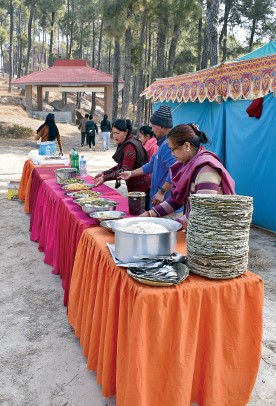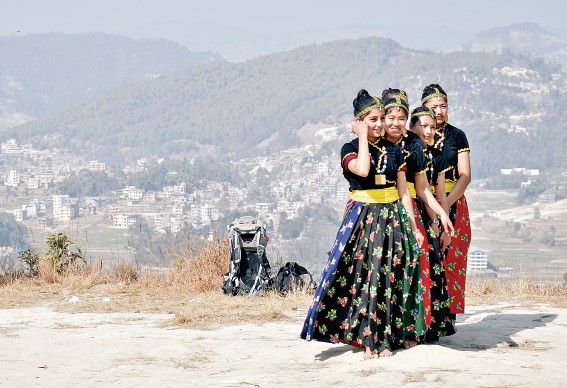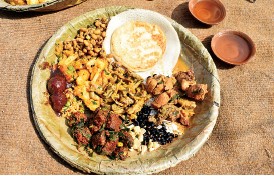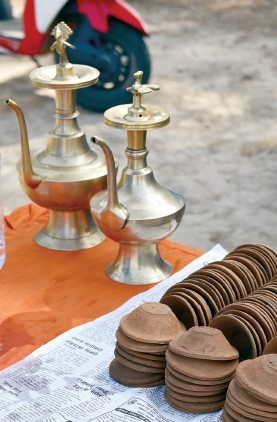The annual Miteri Chhatrabritti Kosh (MCK) Scholarship Walk is a representation of two of Nepal’s most apparent aspects: friendship and food. It provides an opportunity to, as the slogan accurately describes, “Walk, Eat, and Do Good.”
It has been my observation that, wherever you go in this affectionate country, you will be welcomed with outstretched arms and a wide smile. Whether you are alone, or in a group, it is second nature to strike up conversations with strangers and make long-lasting friends, and the MCK Walk was no exception.
When we arrived in Banepa at around 10:00 a.m. on February 3, we were greeted by a friendly crowd who were ready to walk for a cause. In between cookies and cups of sweet tea, eager altruists mingled and shared stories of past years and MCK’s future plans. Barbara Butterworth and Michael Gill, the patrons of the program, rose at the front and gave an explanation of their intentions in starting and continuing the walk for the past thirty-one years.
Barbara Butterworth, who was originally working as a Peace Corps volunteer, founded MCK in 1987 to provide funds for Banepa students to go through and finish school. Since the program began, over four hundred students have been assisted in more than fifty public schools in Kavre District, and the numbers are growing each year. The organization is truly changing the lives of children, who otherwise might not have the opportunity to receive an education.

The aim of the day was to walk from Banepa to Panauti, though city, then village, then hillside. After being marked with tikas on our foreheads and red bands around our necks, around one hundred-and-fifty people set off genially together through colorfully flagged streets that bustled with mid-morning traffic. Slowly, the city life ebbed and gave way to wider spaces. Buildings were spread between farmlands, where women in colorful clothing tended the dry ground. Sheep and baby goats lay in sunny patches of grass and watched placidly as we marched past.
 The terrain steadily shifted from flat to incline as we entered the hills. Jackets were removed, and pants rolled up, as the midday sun shone down with excitement. There was soon nothing around us but grass and trees, as we clambered up rocks and shoe-pounded paths. As I walked, I flitted between different groups and listened to people’s stories. In the typical Nepali fashion, everyone was eager to share.
The terrain steadily shifted from flat to incline as we entered the hills. Jackets were removed, and pants rolled up, as the midday sun shone down with excitement. There was soon nothing around us but grass and trees, as we clambered up rocks and shoe-pounded paths. As I walked, I flitted between different groups and listened to people’s stories. In the typical Nepali fashion, everyone was eager to share.
For a while, I walked with a group of schoolgirls who lived in the area and had been attending the walk for several years. I then met a teenager who had left her family at the back of the procession out of exasperation at their slow-moving legs, and two men who seemed to have done just about every trek in the country. Many of these encounters were with people I will likely never meet again, but several I have already run into— whether accidentally on a sandy hike in Nagarkot, or by planned occasion at one of Kathmandu’s local restaurants. Through the act of doing good and helping the lives of children around Nepal, we were also embodying the age-old sense of community and companionship among one another. Each and every person that walked alongside me, I see as a friend.
Our group crested the hilltop to survey a landscape of stacked fields and hazy hills. In the dust, distance can be measured in shades. The clearest things are right in front of you, and layers beyond that grow closer and closer to the solid beige of far-off places.
 Before us on the hill, thankfully clear and blessedly close, an extensive Newari feast was laid out on several long tables. Bowls overflowing with spicy meats, curried mushrooms, and steaming flat breads were lined up in a mouth-watering display, and we heaped spoonfuls onto disposable plates made of dried banana leaves. Spices hung in the air, stinging noses and enticing hungry stomachs. Nepali beer and traditional raksi liquor served in clay cups were freely available to wash down the delicious meal. We followed the tradition of smashing the clay raksi cups, so that their pieces could return to the ground from which they came, though admittedly, it took us more than one try, due to weak throws or inconveniently positioned patches of grass.
Before us on the hill, thankfully clear and blessedly close, an extensive Newari feast was laid out on several long tables. Bowls overflowing with spicy meats, curried mushrooms, and steaming flat breads were lined up in a mouth-watering display, and we heaped spoonfuls onto disposable plates made of dried banana leaves. Spices hung in the air, stinging noses and enticing hungry stomachs. Nepali beer and traditional raksi liquor served in clay cups were freely available to wash down the delicious meal. We followed the tradition of smashing the clay raksi cups, so that their pieces could return to the ground from which they came, though admittedly, it took us more than one try, due to weak throws or inconveniently positioned patches of grass.
In a blissful state of post-feast euphoria, the group’s attention was directed to a music and dance performance by girls from the Vidya Sagar School. Their colorful costumes and softly padding bare feet, accompanied by a slightly faulty sound system, charmed the audience completely. The performances grew more casual, one of which consisted of a very young child dancing a flawless solo routine. The dancers pulled bystanders in to join their merriment, and I myself was taken up in a whirl of skirts and smiles and circling chains. We took turns leading the group, and people of all ages shared in the joys of traditional Nepali dance.
Just as the day was winding to an end, and before we departed on our separate ways, the far-away haze lifted enough to reveal a trace of the distant Himalaya beyond the hills—unequivocally settling the ongoing debate on whether or not the white triangles of cloud were in fact the snowcapped mountain range. We breathed in deeply and surveyed the exquisite country below us. It is a country full of people who care, people who cook, and people who do good.












